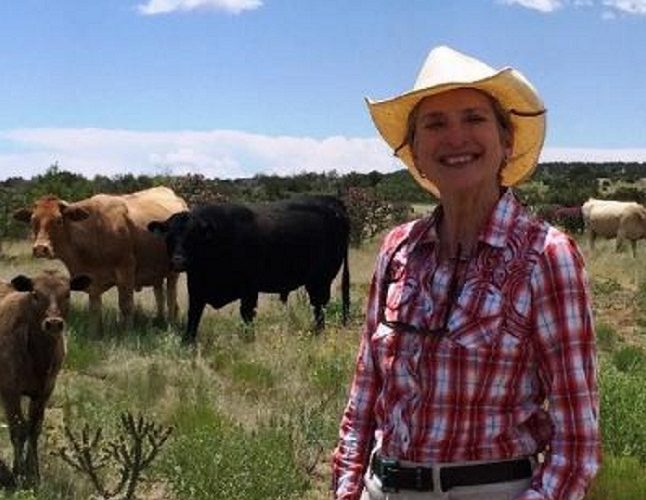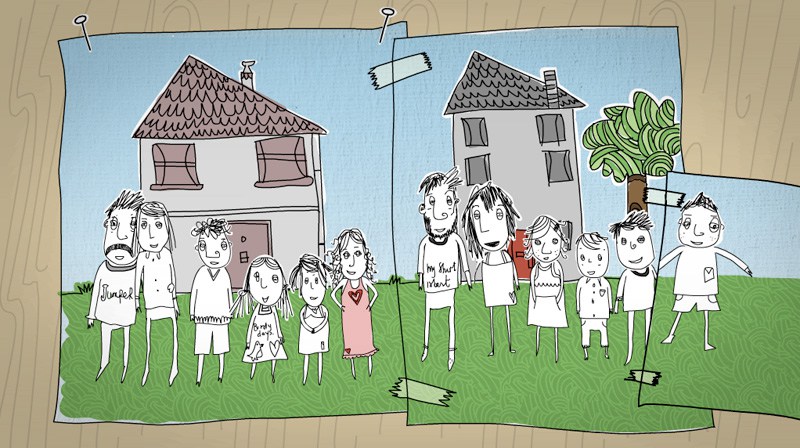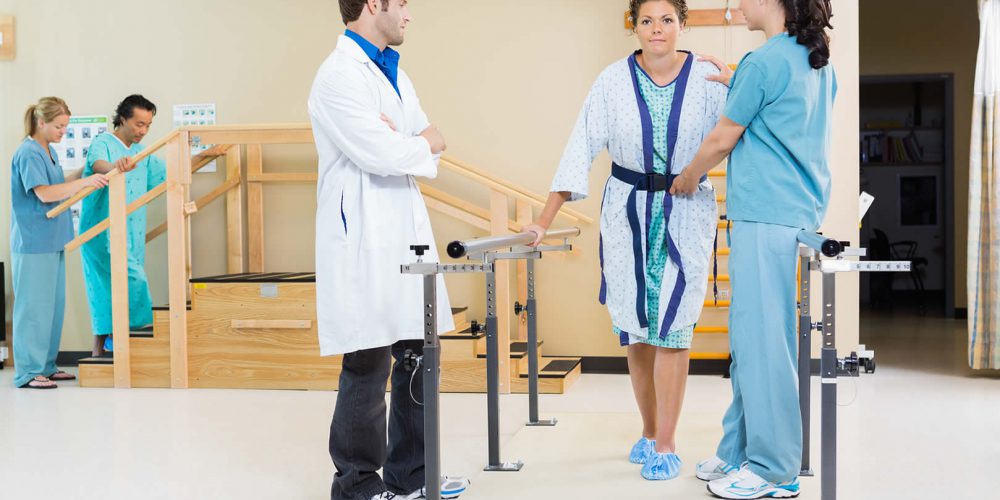Investing in infrastructure to avoid deluges occurring far more often than decades ago

July, August and September 2023 were marked in Chicago, Cleveland and Detroit by torrential rainfalls which caused deluges there.
The National Weather Service reported that on July 2, 2023 “multiple nearly stationary bands of showers and thunderstorms” dumped up to 9.1 inches of rain in some areas of Chicago. Flash floods inundated roadways, more than 10,000 homes reported flood-related damage, and preliminary estimates of losses totaled a half-billion dollars. A federal disaster was declared.
Chicago wasn’t alone in its misery. A few weeks later and a few hundred miles to the east, the city of Cleveland saw its own deluge on Aug. 23. Cleveland’s west side saw so many vital underpasses flooded that the neighborhood was virtually cut off for hours.

And Detroiters often deal with periodic heavy rains and power outages, with specific neighborhoods feeling the brunt during individual storms. The last widespread, catastrophic event, in June 2021, inundated parts of the Grosse Pointes, Detroit’s east side and Dearborn.
It’s a situation that is likely to intensify in Illinois, Michigan and Ohio, creating recurring threats to property, health and finances — for residents, and for cities and states.
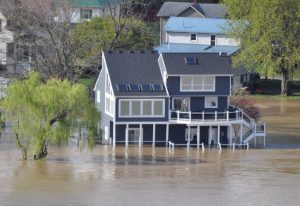
With chronic deluges occurring far more often than decades ago, there’s no escaping today’s reality: Climate changes and their effects mean that flooding in urban centers can no longer be ignored as rare acts of nature. Indeed, the Chicago area saw a virtual repeat of July 2’s flooding just weeks later in mid-September.
Images of torrential rainfall that flooded New York City streets and subway lines in September 2023 also increase awareness of how widespread urban flooding has become.
The question for cities now is what to do about it.
According to the Fifth National Climate Assessment, the U.S. government’s report on climate change, heavy storms became 45% more frequent in the Midwest from 1958 to 2021. Aaron Wilson, Ohio’s state hydrologist, said Cleveland Hopkins International Airport got more than 3 inches of rain in a day just four times in the 55 years from 1950 through 2004; that more than doubled to nine times in just the next 19 years.
In and around Grand Rapids, rain has increased more than 18% over the last 100 years, with nearly 25% more falling in areas just north and east of the city, some of the biggest precipitation increases in the state of Michigan, according to precipitation data from the National Oceanic and Atmospheric Administration.

“We’re getting much heavier rain, and the intensity of the rain is incredible,” Candice Miller, public works commissioner for Macomb County outside Detroit said. “We’re struggling with it just like everybody else. We have to think how we can position ourselves for the future.”
Predicting such events with precision is difficult because, as the weather service notes, the most extreme rainfall is often quite isolated. The difference of a few miles can mean rain falling harmlessly or devastating flooding, and that devastation has real consequences.
Accurately define the issues
Flooding certainly can involve a river overflowing its banks, but urban flooding often stems from other causes and requires other solutions. As a 2019 report by the Natural Resources Defense Council put it, “Urban flooding has little to do with bodies of water.” Rather, says Anna Weber, an NRDC senior policy analyst, urban flooding results from excessive rainfall and the inability of the existing capacity in our stormwater systems — gray infrastructure — to deal with it.
For example, in the 2021 event in Detroit, the failure of electric power to a key pumping station on the city’s east side contributed to massive backflow of rainwater into streets and basements in the Grosse Pointes. But even if the power hadn’t failed, so much rain fell that the existing pipes and pumps couldn’t have handled it all.
Flooding was inevitable, officials said
What makes the problem worse is that in many older cities, the underground drains, pipes and pumps that carry away rainwater is the same setup that deals with sewage. Newer suburban communities often separate the stormwater and sewer systems. But in older neighborhoods, heavy rain mixes with sewage and sometimes backs up into basements, streets and nearby waterways.
Whether combined or separated, these urban water and sewer systems are vastly complex networks that carry freshwater into homes and businesses and carry away waste as well as rain runoff and snowmelt. Across Chicago, Detroit and Cleveland, millions of homes and businesses connect to these underground networks. These systems were built over many decades and are hugely expensive to maintain and upgrade.
And here’s the rub: The cities designed and built their underground infrastructure for the kind of rainstorms they saw 50 or a 100 years ago, not for today’s increasingly more severe storms. When the rain comes tumbling down, it often has no place to flow except where it hurts humans the most: streets and basements.
Protect the most vulnerable
Losses from urban flooding can run into billions of dollars in property damage. Beyond that, urban flooding can also create health concerns ranging from stress to asthma stemming from mold exposure. Actual losses may be even greater than official estimates of property damage once health impacts and loss of gross domestic product are considered.
In the Midwest, the impact of excessive rain — urban flooding — often hurts poorer neighborhoods of color the most.

Then, too, economically poorer areas often are locales of more heavy industry, paved over with asphalt and with fewer natural greenspaces to absorb heavy rains. And low-income areas tend to see fewer upgrades and less reinvestment in infrastructure. “There really hasn’t been a funding scheme to support low-income communities on the maintenance piece,” Alias said.
Finally, urban flooding is often too localized to draw in state or federal aid. As the 2019 NRDC report put it, “This limits the public assistance available to victims, who are then left on their own to deal with the aftermath, over and over again.”
Such complaints are heard in many cities. Residents of the Delray neighborhood in southwest Detroit have long complained about bearing the brunt of heavy industry and the problems it brings. Expansion, growth and development upstream can often cause floods downstream. As Ohio hydrologist Wilson said, “More vulnerable, poor communities tend to be in the lower-lying areas.”
Improve the infrastructure
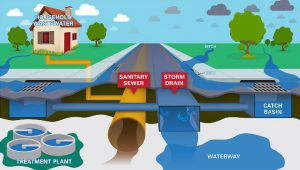
Attempts to build out of the flooding problem with expanded systems are chasing the increasing impacts of climate change. Who is to say the 9 inches of rain Chicago received last summer will be the peak — is it just a harbinger of even worse to come?
But while the cities are working, often with federal relief dollars, to upgrade their stormwater systems, installing bigger pipes and more efficient pumps, Weber of the NRDC contends that these “gray infrastructure” projects, while necessary, are insufficient to deal with today’s urban flooding.
That’s because many of the biggest problems stem from heavy rainfall exacerbating other issues — inadequate housing, poverty, health risks, lack of green spaces and underlying contamination from prior industrial uses.
“None of these questions exist in a silo,” Weber said. “When you’re talking about flooding, you can’t be just talking about flooding. Flooding affects everything in a community, so you need to be thinking about these holistic solutions. We need to look at solutions that have multiple benefits.”
Every region’s long-term goal is to better maintain the existing infrastructure and improve it as necessary.
The Northeast Ohio Regional Sewer District has overseen $9 billion in improvements since its start in 1972, and its leaders expect to spend another $6 billion. They intend their current and future tunnels to hold back 98% of the combined sewer overflow from a two-year storm until there’s room at treatment plants downstream. They say bigger tunnels would cost too much. As it is, the district has reduced untreated overflows from about 9 billion gallons per year to 4.5 billion, and it aims for 494 million by 2036.
In Southeast Michigan, the Michigan Department of Transportation has been installing new electric generators at each of its 144 pumping stations along Detroit-area freeways to help remove water from roadways.
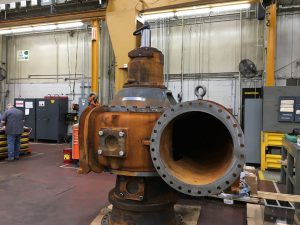
Since the 2021 flooding in Detroit, the Great Lakes Water Authority, or GLWA, has mapped out hundreds of millions of dollars of upgrades to its stormwater system, many of them already underway.
Among the steps: Upgrading the electric power supply to pumping stations like the one at Conner Street and East Jefferson Avenue, where power failures in 2021 contributed to the disastrous flooding on the east side. New pipes and pumping upgrades are underway elsewhere along the system as well. And officials say communication lines with suburban systems have improved so that storm flows may be diverted from one part of the system to where more capacity is available.
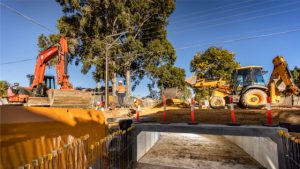
Sometimes it’s just a matter of keeping water out of underground systems by forging alternatives. Consider the new Gordie Howe International Bridge now under construction over the Detroit River to Canada, along with a 167-acre Port of Entry inspection complex in southwest Detroit. Initially, GLWA CEO Suzanne Coffey says, bridge planners had expected to direct stormwater runoff from the facility into the underground pipes that the authority operates. But GLWA planners persuaded the bridge builders to direct heavy rain from the site into the river itself, sparing the underground system that extra burden.
Still, as Coffey notes, the regional stormwater system was designed to handle about 3.3 inches of rain a day, not the 7 to 8 inches of rain at a time that sometimes deluges Detroit as it did in 2021. But the upgrades and better planning are paying off in greater resiliency.
“If we get 10 inches of rain, would we have flooding? Yes,” she says. “Are we much better prepared? You bet.”
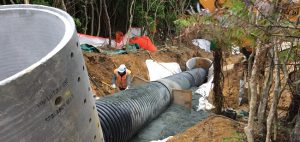
In Detroit itself, the water department operates a machine known as a “nutcracker” to break up concrete that construction crews have dumped down drains at the end of a job to get rid of it. Blockages like that clog the stormwater system and can lead to backups and flooding.
In Macomb County outside Detroit, Public Works Commissioner Miller has been working to have hundreds of stormwater drains cleared of sediment, debris and junk.
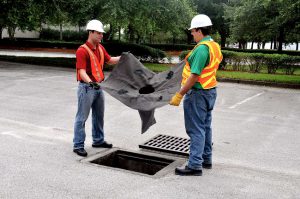
“You can’t believe what you can find when you start inspecting,” Miller said. “We have 500 drains, big drains, some enclosed, some not inspected since the 1960s. You have to spend money on inspecting old, enclosed drains and cleaning them out. Make sure all the assets you have are operating optimally.”
Encourage individuals to do their part
But upgraded and cleaned out pipes and greener rainwater basins aren’t enough, Weber argues. There also needs to be a social component to any efforts to reduce the damage from urban flooding.
Some of those solutions are being funded, in part, in Chicago by the city’s Climate Infrastructure Fund, which provides grants of $50,000 to $250,000 to nonprofit organizations and small businesses for climate-related capital projects in priority areas such as green infrastructure.
If the big solutions cost billions of dollars and require government action, individual homeowners can take steps, too, to protect themselves.
Homeowners can install backup protection valves that prevent sewer overflows from backing up into a basement. Then, too, homeowners can regrade their yards so that rainwater flows away from the foundation, lessening basement flooding. Gutter downspouts can be disconnected from the sewer system and repositioned to flow rainwater into a nearby rainwater garden where plants can absorb the overflow.
Some communities let residents replace grass with native ground cover or vegetation. “To my way of thinking, it’s more attractive,” says Mayor William Tomko of Northeast Ohio’s Chagrin Falls. And homeowners can plant trees where roots will suck up excess groundwater.

One more thing officials encourage: The next time a millage proposal shows up on the ballot to support stormwater system upgrades, vote “yes.”
With such a complex problem, the solutions have to come from many different quarters — government and business and nonprofits and individuals. “We can’t be operating in silos,” Weber of the NRDC said. “Everybody has a role to play in these solutions and we all have to be learning from each other. Otherwise, we just keep reinventing the wheel.”
As Kyle Dreyfuss-Wells, who leads the Cleveland-area’s Northeast Ohio Regional Sewer District, says, “We got here by a thousand cuts. We’re only going to get out of here by a thousand steps.”
Some of those solutions may be hugely expensive, but Macomb County’s Miller says people can’t be discouraged.
“We have been behind the eight ball by not investing enough in our infrastructure. Everybody knows that,” she said, but added, “You can’t look at anything that way. You have to think about incremental changes and doing a better job, what you can afford, and think creatively and utilize value engineering in any way you can: like an elephant — one bite at a time.”
By Alex Arlander | ENC News
























